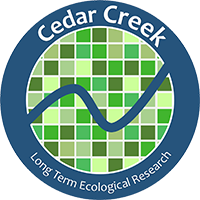There are four levels of nitrogen, corresponding to treatments A, C, F and G in E001, applied at the same time as in that experiment. For a description of fertilizer added to E052, see file fertilization details. There are four levels of soil disturbance designated 1, 2, 3 and 4.
Level 1: undisturbed
Level 2: 1 pass with a 7 HP Honda rear-tined rototiller with the elevator set to till to a depth of 9 inches
Level 3: 2 passes or however many required to produce about 50% bare ground
Level 4: 3 passes or however many required to produce 100% bare ground. This requires 3 passes in some plots but 5 or 6 in others. In addition, all woody vegetation not destroyed by tilling is cut at the base.
Rototilling is applied in late April.
Each fertilization treatment receives each disturbance treatment, for a total of sixteen treatments. There are four replicates of each of the sixteen treatments. In addition, the four extreme ends (lowest N, lowest disturbance; highest N, lowest disturbance, etc. ) are replicated an additional ten times. Treatments are applied in a completely randomized design. Each of the 104 plots is 5m x 5m.
Measurements taken at E052 will include: 1) species abundances, 2) community biomass allocation to leaves/roots/stems/flowers, 3) above and below ground net primary production and 4) rates of nitrogen mineralization. For a list of treatments, see the treatment layouts in file trmte52.
The plots in E052 are enclosed by a fence to exclude mammalian herbivores. Galvanized welded-wire hardware cloth with 6mm x 6mm openings was buried to a depth of 50cm. Additional hardware cloth extends 60cm above the ground and poultry netting extends to 2m above the ground.
In 1990, ten plots of each of four treatments (N1D1, N1D4, N4D1, N4D4, where N is the level of nitrogen added and D is the disturbance treatment) were randomly selected for the competition experiment. The above and belowground effects of neighbors on transplanted grass seedlings were measured using three competition treatments: transplants were grown in 50cm diameter subplots 1) with no neighbors, 2) with the roots but not shoots of neighbors, 3) with all above and belowground parts of neighbors present. One transplant was grown in the center of each subplot. Competition treatments were applied to subplots within the main plots during 14-18 May, 1990. Competition treatments were replicated three times in each of the ten replicate plots for each of the four combinations of nitrogen supply rate and disturbance. Thus, the 40 plots of the nitrogen and disturbance combinations (2 nitrogen levels x 2 disturbance levels x 10 replicates) each contained 9 subplots (3 competition treatments x 3 replicates), each subplot comprising one transplant in one competition treatment. A total of 360 seedlings were transplanted. Competition treatments were assigned randomly to subplots within each plot.
In 1991, three species of contrasting sizes, life histories, growth rates and positions along gradients of nitrogen and disturbance in the experiment were used: Schizachyrium scoparium, Agropyron repens, and Setaria viridis. Transplants were grown individually in subplots, with 1) all neighbors and 2) no neighbors. The experiment was conducted in high and low nutrient environments to test for the interaction between the environment, the size and the species. There were ten replicate plots of each of the two environments, one receiving no additional nitrogen and the second receiving nitrogen at 17g/m2/yr. In total, there were 32 transplants (3 species x 3 size classes x 2 competition treatments x 1, 2 or 3 replicates) in each plot, and 20 plots (2 environments x 10 replicates), or 640 transplants. Seedlings were transplanted into the field during 3-6 June, 1991.
